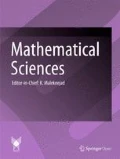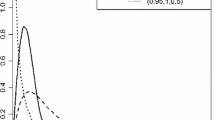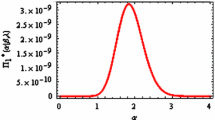Abstract
Applications of misspecified models in the field of survival analysis particularly frailty models may result in poor generalization and biases. Since gamma and inverse Gaussian distributions are often used interchangeably as frailty distributions for heterogeneous survival data, clear distinction between them is necessary. Based on closed form expressions of unconditional hazards and survival functions, in this paper we compare the effectiveness of gamma and inverse Gaussian distributions for frailty term in modeling survival data for heterogeneous populations. Different baseline hazards were considered including exponential, Weibull and Gompertz. We derived the closed form expressions for unconditional hazards and survival functions under each baseline distribution for both gamma and inverse Gaussian frailty models. Both graphical and extensive statistical simulation approaches are applied to compare the models. For the inference purpose, real data concerning the East Coast Fever (ECF) transmission dynamics is applied. General overview from the graphical analysis and results from both real and synthetic data indicate that gamma distribution under the Gompertz and Weibull baseline hazards is better compared to inverse Gaussian in modeling survival data for a heterogeneous population. Simulation, graphical and inferential analyses were done using appropriate packages in R language.








Similar content being viewed by others
References
Vaupel, J.W., Manton, K.G., Stallard, E.: Impact of heterogeneity in individual frailty on the dynamics of mortality. Demography 16, 439–454 (1979)
Gupta, R.C., Gupta, R.D.: General frailty model and stochastic orderings. J. Stat. Plann. Inference 139, 3277–3287 (2009)
Hanagal, D.D.: Correlated positive stable frailty models. Commun. Stat. Theory Methods. https://doi.org/10.1080/03610926.2020.1736305 (2020) (in press)
Govindarajulu, U.S., Lin, H., Lunetta, K.L., D’Agostino, R.: Frailty models: applications to biomedical and genetic studies. Stat. Med. 30(22), 2754–2764 (2011)
Wienke, A.: Frailty Models in Survival Analysis. Chapman & Hall/CRC Biostatistics Series, New York (2011)
Hanagal, D.D., Pandey, A., Ganguly, A.: Correlated gamma frailty models for bivariate survival data. Commun. Stat. Simul. Comput. 46(5), 3627–3644 (2017)
Jiang, X., Liu, W., Zhang, B.: A note on the prediction of frailties with misspecified shared frailty models. J. Stat. Comput. Simul. https://doi.org/10.1080/00949655.2020.1811279 (2020) (in press)
Weiss, K.M.: Biodemography of variation in human frailty. Demography 27, 185–206 (1990)
Heckman, J.J., Singer, B.: Identifiability of the proportional hazard model. Rev. Econ. Stud. 51, 231–241 (1984)
Hougaard, P.: Frailty models for survival data. Lifetime Data Anal. 1, 255–273 (1995)
Hougaard, P.: Analysis of Multivariate Survival Data. Springer, New York (2000)
Agresti, A., Caffo, B., Ohman-Strickland, P.: Examples in which misspecification of a random effects distribution reduces efficiency, and possible remedies. Comput. Stat. Data. Anal. 47(3), 639–653 (2004)
Hanagal, D.D., Bhambure, S.M.: Modeling bivariate survival data using shared inverse Gaussian frailty model. Commun. Stat. Theory Methods 45(17), 4969–4987 (2016)
Hanagal, D.D., Pandey, A.: Correlated gamma frailty models for bivariate survival data based on reversed hazard rate. Int. J. Data Sci. 2(4), 301–324 (2017)
East Coast Fever (ECF) transmission dynamics dataset. http://www.vetstat.ugent.be/research/frailty/datasets/
Greenwood, M., Yule, G.: An inquiry into the nature of frequency distributions representative of multiple happenings with particular reference to the occurrence of multiple attacks of disease or of repeated accidents. J. R. Stat. Soc. 83(2), 255–279 (1920)
Beard, R.E.: Note on some mathematical mortality models. The lifespan of animals. In: Wolstenholme, G.E.W., O’Conner, M. (eds.) Ciba Foundation Colloquium on Ageing, pp. 302–311. Little Brown and Company, Boston (1959)
Congdon, P.: Modeling frailty in area mortality. Stat. Med. 14, 1859–1874 (1995)
dos Santos, D.M., Davies, R.B., Francis, B.: Nonparametric hazard versus nonparametric frailty distribution in modelling recurrence of breast cancer. J. Stat. Plan. Inference 47, 111–127 (1995)
Duchateau, L., Janssen, P.: Frailty Model. Springer, New York (2008)
Pandey, A., Lalpawimawha, R.: Comparison of correlated frailty models. Commun. Stat. Simul. Comput. https://doi.org/10.1080/03610918.2020.1770287 (2020) (in press)
Hanagal, D.D.: Modeling Survival Data Using Frailty Models, 2nd edn. Springer Nature, Singapore (2019)
Hougaard, P.: Life table methods for heterogeneous populations. Biometrika 71, 75–83 (1984)
Manton, K., Stallard, E., Vaupel, J.: Alternative models for heterogeneity of mortality risks among the aged. J. Am. Stat. Assoc. 81, 635–644 (1986)
Klein, J.P., Moeschberger, M., Li, Y.H., Wang, S.T., Flournoy, N.: Estimating random effects in the Framingham Heart Study. In: Klein, J.P., Goel, P.K. (eds.) Survival Analysis: State of the Art. Nato Science (Series E: Applied Sciences), vol. 211. Springer, Dordrecht (1992)
Keiding, N., Andersen, P., Klein, J.: The role of frailty models and accelerated failure time models in describing heterogeneity due to omitted. Stat. Med. 16(1–3), 215–224 (1997)
Price, D.L., Manatunga, A.K.: Modelling survival data with a cured fraction using frailty models. Stat. Med. 20(9–10), 1515–1527 (2001)
Economou, P., Caroni, C.: Graphical tests for the assumption of gamma and inverse Gaussian frailty distributions. Lifetime Data Anal. 11, 565–582 (2005)
Kheiri, S., Kimber, A., Meshani, M.R.: Bayesian analysis of an inverse Gaussian correlated frailty model. Comput. Stat. Data Anal. 51(11), 5317–5326 (2007)
Punzo, A.: A new look at the inverse Gaussian distribution with applications to insurance and economic data. J. Appl. Stat. 46(7), 1260–1287 (2019)
Hanagal, D.D.: Modeling Survival Data Using Frailty Models. Chapman & Hall, New York (2011)
Rizzle, M.L.: Statistical Computing with R. Chapman & Hall/CRC The R Series, New York (2007)
Boos, D.D.: Introduction to the Bootstrap World. Statistical Science, 18(2), Silver Anniversary of the Bootstrap, 168-174 (2003)
Chernick, M.R., LaBudde, R.A.: Introduction to Bootstrap Method with Application to R. Wiley, New York (2011)
Acknowledgements
The authors would like to thank the referees for their valuable comments and suggestions to improve the quality of the publication.
Author information
Authors and Affiliations
Corresponding author
Rights and permissions
About this article
Cite this article
Ata Tutkun, N., Marthin, P. A comparative study with bootstrap resampling technique to uncover behavior of unconditional hazards and survival functions for gamma and inverse Gaussian frailty models. Math Sci 15, 99–109 (2021). https://doi.org/10.1007/s40096-020-00366-1
Received:
Accepted:
Published:
Issue Date:
DOI: https://doi.org/10.1007/s40096-020-00366-1




